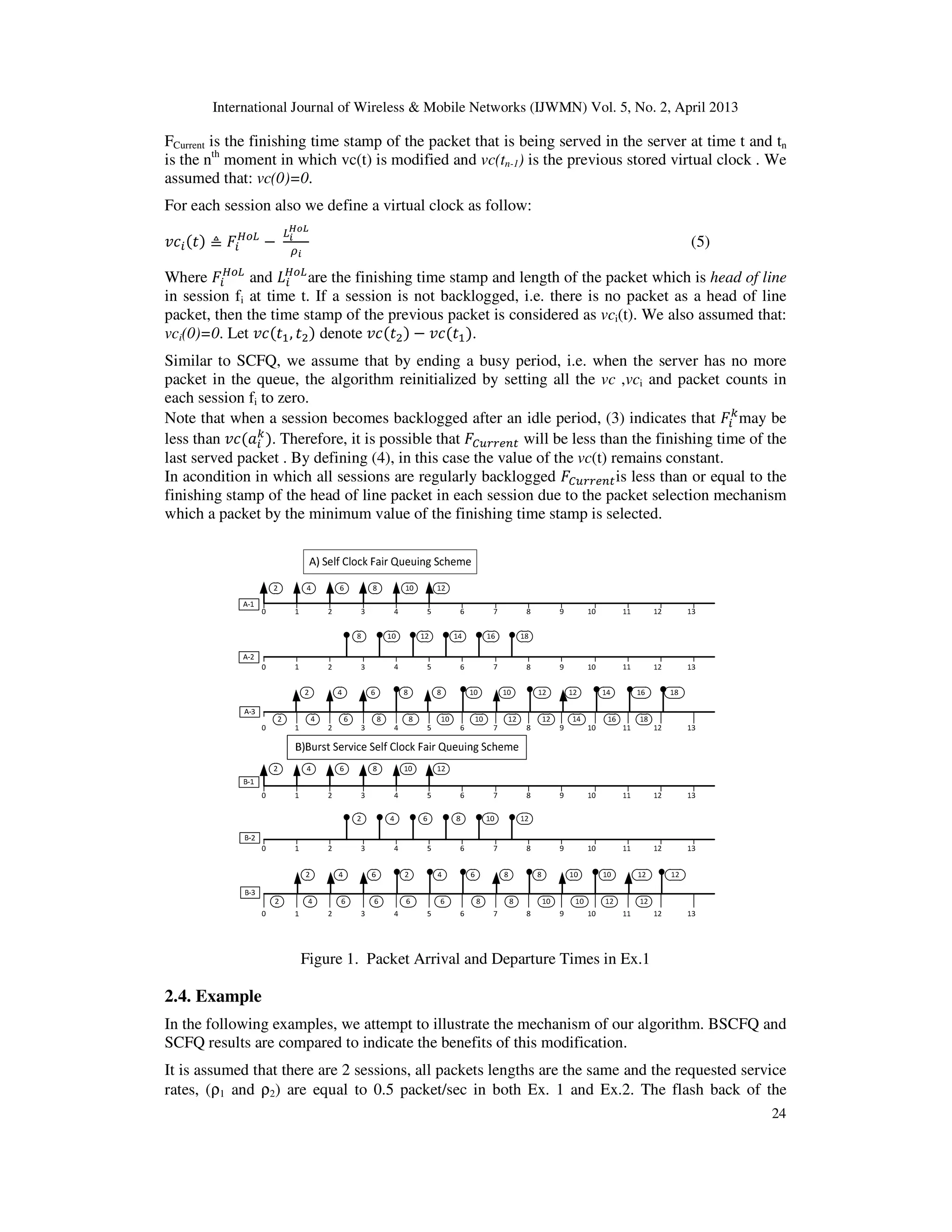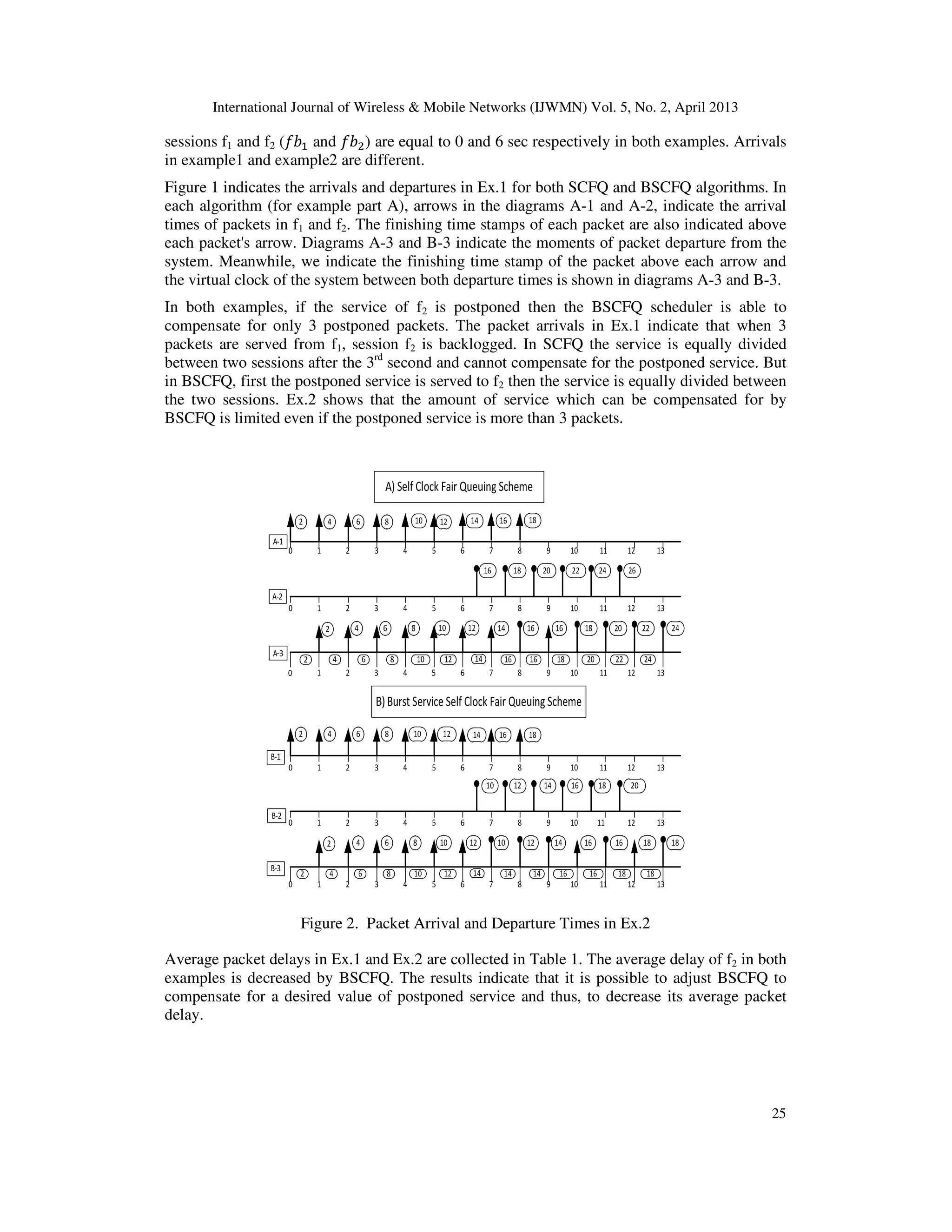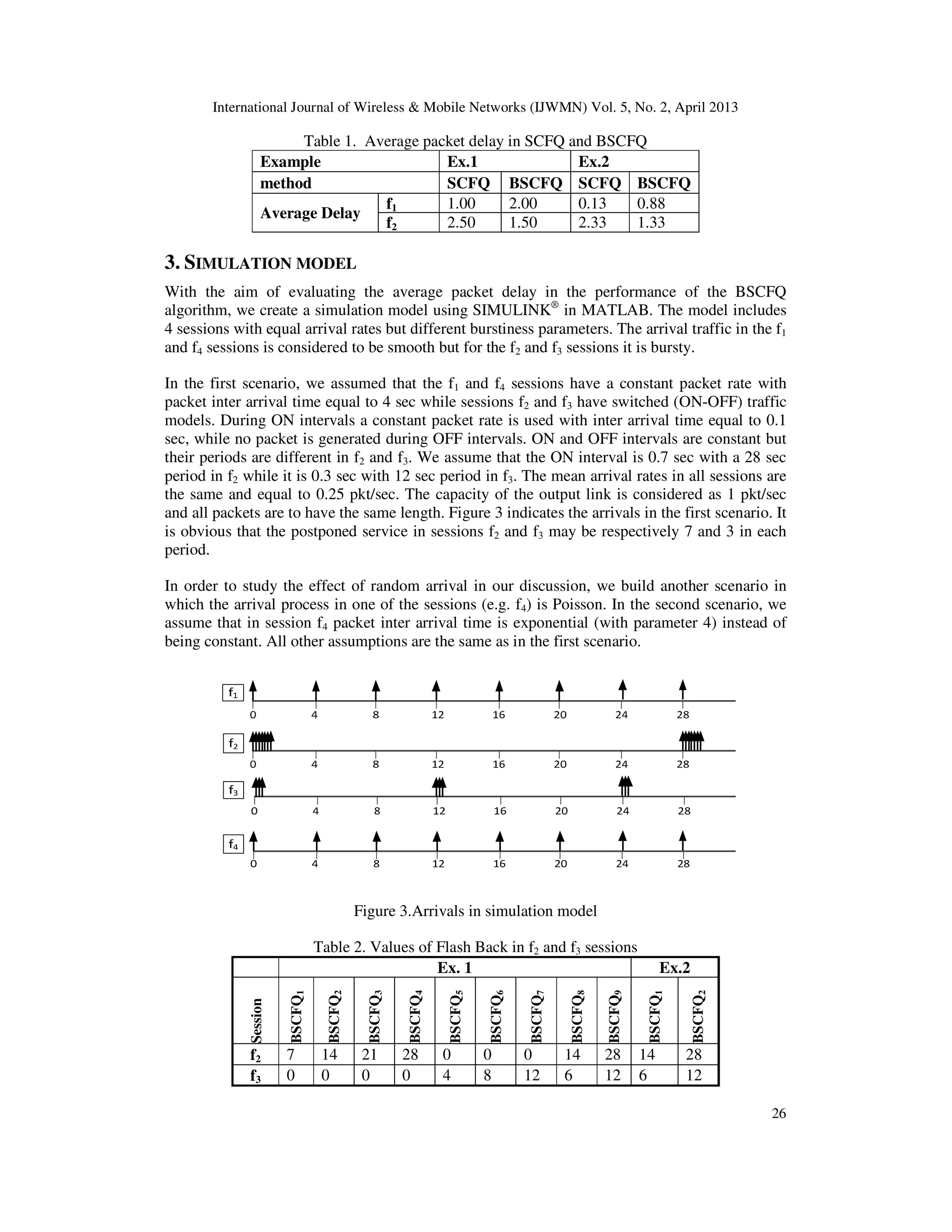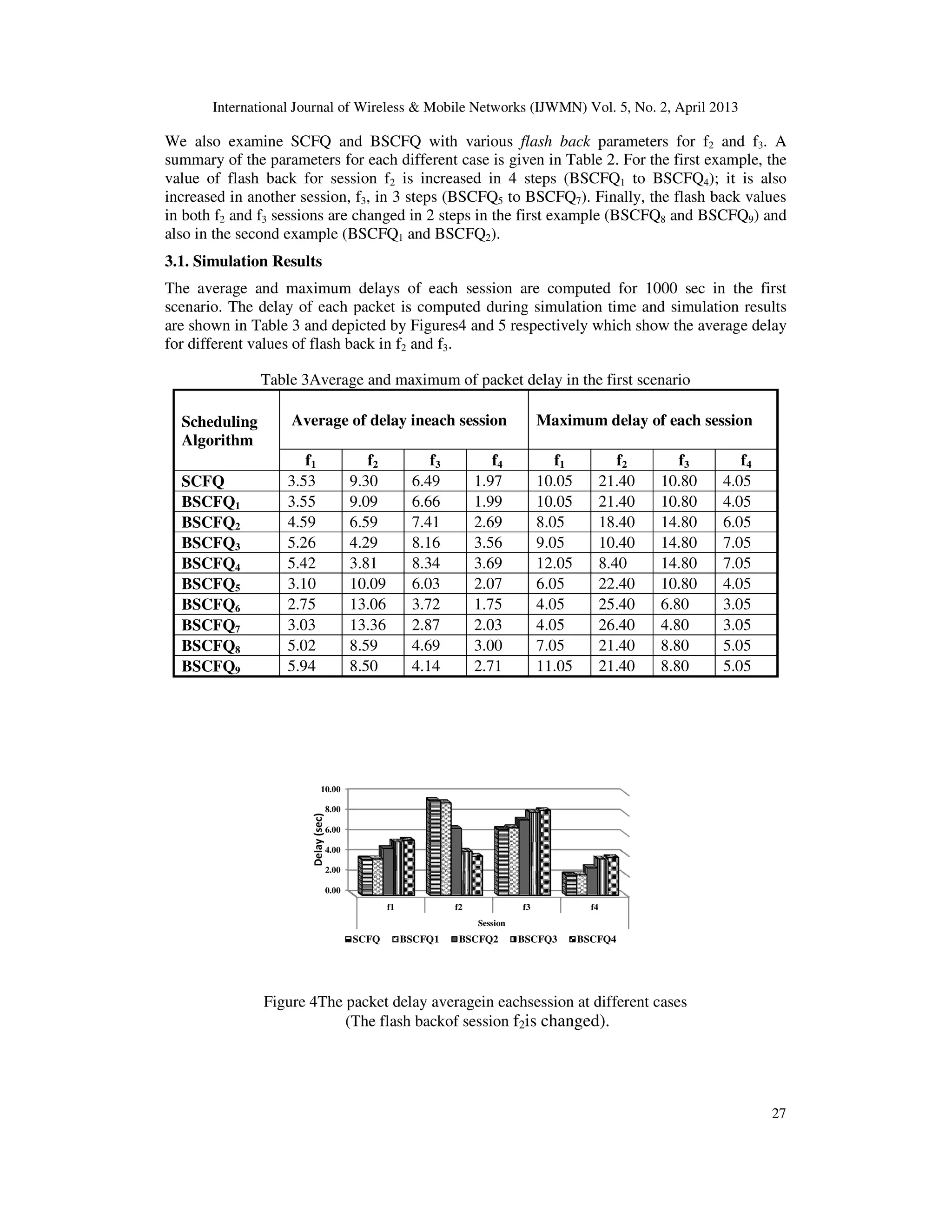The document presents an improved scheduling algorithm named Burst-Service Self Clock Fair Queuing (BSCFQ) designed to enhance quality of service (QoS) for bursty traffic in multimedia networks. This algorithm modifies the well-known SCFQ to better accommodate burst delays by introducing a compensable service threshold without requiring additional computation. The performance evaluation through simulations shows that BSCFQ effectively reduces average packet delays for bursty sessions compared to traditional methods.
![International Journal of Wireless & Mobile Networks (IJWMN) Vol. 5, No. 2, April 2013
DOI : 10.5121/ijwmn.2013.5202 21
IMPROVING SCFQ TO SUPPORT BURSTY TRAFFIC
Mahmoud Daneshvar Farzanegan1
, Hossein Saidi1
andMehdiMahdavi1
1
ECE Department, Isfahan University of Technology, Isfahan, Iran
m_daneshvar@ec.iut.ac.ir,[hsaidi, m_mahdavi]@cc.iut.ac.ir
ABSTRACT
Quality of Service (QoS) provisioning in networks requires proper scheduling algorithm. Internet traffic,
especially real-time multimedia applications, is bursty in nature . Hence, in addition to the service rate
which is commonly used to isolate service of sessions, other parameters should be involved. In this paper
a scheduling algorithm is proposed that attempts to provide a balance between bursty and non-bursty
(smooth) traffic. We improve thewell-known packet scheduling algorithm, SCFQ.Our proposed algorithm
is proficient to compensate an adjustable amount of missed service to each session. The average delay of
the proposed algorithm is evaluated by simulation. An important advantage of our algorithm is that
byselecting correct parameter setting for each session, the average delay of a bursty session can be
reduced. Furthermore, compared to SCFQ our proposed algorithm does not necessitate any additional
computation.
KEYWORDS
Scheduling, Fair Queuing, QoS, Bursty traffic
1. INTRODUCTION
Different kinds of services in multimedia networks need different kinds of quality of services
(QoS). QoS is usually quantified by end-to-end delay, service rate, delay variation (jitter) and
packet loss rate. QoS provision might be accomplished in different network layers or devices
such as switches or routers. Due to their key role in QoS provisioning, scheduling algorithms
have received much attention in the literature [1]-[6].
In the development of packet scheduling algorithms, with respect to internal structures, there are
two categories of scheduling algorithms: sorted-priority and frame-based [1]. In a sorted-
priority category, a set of potential functions or virtual clocks are defined. When a packet
arrives in or departs from the server, the values of the virtual clock are updated. For each
waiting packet in the queue, a time stamp is calculated from the virtual clocks. The scheduler
sorts packets in order of the time stamps and serves a packet with the highest priority [7]-[8]. A
useful survey can be found in [2].
In the other category i.e. frame-based, a duration of time is defined as the frame which includes
time-slots. Based on the requested service rate, each session reserves some time-slots in the
frame. The round robin family is a major kind of algorithms in this category [9],[10].
In both of the above categories, the reserved or requested service rate is usually applied to
isolate sessions. Many kinds of packet scheduling algorithms e.g. WFQ, SCFQ, GR, DRR etc.
have been proposed to distribute available bandwidth fairly among all backlogged sessions in
terms of requested service rates, hence, this kind of scheduling algorithm is called Rate
Proportional Server (RPS)[1]. However, most of the RPS schedulers do not have acceptable
performance when bursty traffic and non-bursty (smooth) sessions compete. Suppose a bursty
and a smooth session, equal in term of requested service rates are scheduled by an RPS. When](https://image.slidesharecdn.com/wmn02-130514035559-phpapp02/75/IMPROVING-SCFQ-TO-SUPPORT-BURSTY-TRAFFIC-1-2048.jpg)
![International Journal of Wireless & Mobile Networks (IJWMN) Vol. 5, No. 2, April 2013
22
the bursty session starts to send data after having been idle while the smooth session received
regular service, the RPS scheduler serves both sessions similarly. Because only the service rates
are involved in the scheduling algorithm, unused service in idle duration cannot return back to
the bursty session. In the next section, the treatment of bursty traffic and non-bursty traffic
under by an RPS scheduler is studied with an example.
The bursty nature of internet traffic [11] and QoS requirements in multimedia applications
motivate us to consider in addition to the requested service rate, another parameter which would
describe the need for bursty service in the scheduling algorithm. However, the scheduling of
bursty traffic has been an attractive subject for investigation.[12]-[28]. In these studies the
authors attempt to design scheduling algorithms that provide acceptable service for bursty traffic
by involving more parameters such as delay due time, unused credit or burst specification in the
scheduling algorithms. By adjusting the proper parameters, a better QoS can be provided to
each bursty session.
In some studies, traffic is modelled by a series of bursts, and the scheduling algorithm takes into
account its special requirements and specifications [17]-[19]. This model is suitable for
compressed video such as the MPEG format [17], or optical burst switches (OBS)[20]-[21].
Some scheduling algorithms which consider bursty traffic and channel disappearance in
wireless networks are studied in [22]-[24]. In [22] some credit values are proposed to count
number of unavailable or unused service for each session. Some other studies define a due time
threshold for each session and the server tries to send the packets within the timing limit of this
threshold [18]-[25].
There are also other methods which use the delay or jitter (i.e. delay variation) parameter as
their main scheduling parameter [26]-[27], due to jitter importance in multimedia applications.
In this group of schedulers, bursty traffic is treated implicitly.
In this paper, we improve SCFQ[7] the famous RPS scheduling algorithm, to provide fair
service to both bursty and non-bursty flows. A dominant feature of SCFQ is that its fairness
index (which is based on the service rate) is less than twice the minimum value that can be
achieved for a packetized scheduling algorithm [7].
The organization of the paper is as follows. Section II presents our proposed scheduling
algorithm named Burst-Service Self Clock Fair Queuing (BSCFQ). In section III, we study the
performance of the proposed scheduling method by a simulation model. Section IV concludes
the paper.
2. BURST SERVICE SCFQ
In this section, we present a modification of a known scheduling scheme named SCFQ that
provides proper service to burst traffic. First, we define some parameters and criteria which are
used in the remainder of the paper.
2.1. Definitions
Definition 1-The amount of service:
Let Sሺݐଵ, ݐଶሻ denote the amount of service which session fi receives during (t1, t2). The amount
of service is equal to the sum of all packet lengths in fi which are completely served by the
server. The amount of service is measured in term of data unit e.g. bit.
Let ߩ denote the reserved service rate, then the relative service of the session fi is shown by
sොሺݐଵ, ݐଶሻ and defined as follows:
ୗሺ௧భ,௧మሻ
ఘ
.](https://image.slidesharecdn.com/wmn02-130514035559-phpapp02/75/IMPROVING-SCFQ-TO-SUPPORT-BURSTY-TRAFFIC-2-2048.jpg)
![International Journal of Wireless & Mobile Networks (IJWMN) Vol. 5, No. 2, April 2013
23
Definition 2- Postponed service:
Due to lack of data, each session fi may receive service which is less than its reserved service.
We call the amount of service which is not offered to a session due to the lack of data as the
"postponed service".
Definition 3- Compensable service threshold:
Compensable service is defined when a server tries to offer more service to a session which has
some amount of postponed service and finally can compensate it in a limited time period. This
amount of postponed service which can be compensated is called compensable service.
Compensating of service should be carried out in a condition in which other sessions are
backlogged. The maximum amount of service which can be compensated by a server for each
session is called its compensable service threshold.
Let γi denote the compensable service threshold for session fi in this paper.
In packet by packet scheduling algorithms (no preemptive type), the server does not start
serving a new packet before the service of the last packet is finished. Therefore, it is possible to
consider a condition in which one packet is served more than accords with the share of session
fi. Consequently, the amount of service may advance up to Li (the maximum packet length in fi).
Therefore, we can say that if session fi has a postponed service equal to Li, the server can
compensate for it in the assumed condition. With respect to definition 3, in packet by packet
scheduling algorithms we can conclude that the compensable service threshold should be at
least equal to Li or:ߛ ܮ (1)
2.2. Self-Clock Fair Queue
SCFQ [7] is a sorted-priority scheduler that defines the finishing time stamp for each packet as
follows: ܨ
ൌ ݉ܽݔ൛ܨ
ିଵ
, ܨ௨௧ൟ
ೖ
ఘ
(2)
Where ܨ
is the finishing time stamp of the kth
packet of session fi. The virtual clock of the
system in SCFQ is denoted by ܨ௨௧ which is equal to the finishing time stamp of the packet
which is being served when the kth
packet arrives. ܮ
and ݎ are the packet length of the kth
packet
and requested service rate in session fi. This formula estimates the finishing service time of each
packet in a fluid flow system and applies it in packet by packet scheduling. The calculating of
(2) is easier than some other estimations such as those in WFQ.
2.3. Burst-Service Self-Clock Fair Queue
In addition to the request service rate, i.e. ρi, we apply another non-negative parameter in
BSCFQ which is named flash back and denoted by fbi. Flash back is a parameter which adjusts
the amount of compensable service threshold by playing back the virtual time of the system in
the session fi's view, therefore fbi is measured by the duration of the second.
The main difference between SCFQ and BSCFQ is in the calculation of the finishing time
stamp. In BSCFQ the finishing time stamp of the kth
packet in fi is calculated as follows:
ܨ
≜ ൝
0 ݇ ൌ 0
݉ܽݔ൛ܨ
ିଵ
, ܿݒሺܽ
ሻ െ ݂ܾൟ
ೖ
ఘ
݇ 0
(3)
Whereܽ
is the arrival time of the kth
packet and ݂ܾ is the flash back parameter in session fi.
vc(t) is the overall virtual clock of the system and defined as:
ܿݒሺݐሻ ≜ ݉ܽ ݔሼܿݒሺݐିଵሻ, ܨ௨௧ሽ ݐ ݐ ൏ ݐାଵ (4)](https://image.slidesharecdn.com/wmn02-130514035559-phpapp02/75/IMPROVING-SCFQ-TO-SUPPORT-BURSTY-TRAFFIC-3-2048.jpg)





![International Journal of Wireless & Mobile Networks (IJWMN) Vol. 5, No. 2, April 2013
29
3.2. Discussion
With respect to Figure 4 and Figure 5, we can see that by increasing the value of flash back of a
session, (our proposed parameter for the adjustment of the amount of compensable service
threshold) the corresponding average delay is decreased. When the flash back of a session
increases, however, average delays in other sessions may either increase (e.g. f1 , f3 and f4 in
Figure4 and f2 in Figure5) or show no noticeable change ( e.g. f1 and f4 in Figure 5). This effect
is predictable due to the fact that overall average packet delay during a busy period is constant
when the server is in work-conserve mode. A work-conserve server is a server which is busy
during every time period that at least one session is backlogged. Therefore, when the average
delay of a session during a busy period decreases, the average delay in other sessions should be
increased or kept constant to ensure the overall average delay remains constant.
Figure 6 indicates the average delay when we want to provide burst service to both of the bursty
sessions. Delay average in both bursty sessions f2 and f3 are reduced by increasing the flash back
value (compare BSCFQ8 and BSCFQ9 with SCFQ). Although average delay in other sessions
(e.g. f1 and f4) increase in BSCFQ8 and BSCFQ9 in comparison with SCFQ, the growing of
average delay in other sessions is slighter than that in BSCFQ4 and BSCFQ7 where the server
provides burst service only to one session.
These results are satisfied when the arrivals in session f4 are random. The results in Figure 7
show as is the case in the first scenario, the average delays of f2 and f3 are reduced in
comparison with the delay in SCFQ.
We can also observe that the average delay of f4 is increased in scenario2 as compared to
scenario1. The random nature of the arrival process can be considered as the main factor in the
increase in the average delay of f4. Therefore, we conclude that BSCFQ can reduce the average
delay of bursty sessions even when the arrival is random.
4. CONCLUSIONS
In this paper, we have proposed BSCFQ to improve SCFQ, as a known RPS scheduling
algorithm. In addition to request service rate,we introduce a new parameter called flash backfor
each session. The flash back parameter has beenused to measure the amount of postponed
service that should be compensated by the BSCFQ server. Therefore, BSCFQ provides better
service to bursty sessions rather than SCFQ.
An important advantage of BSCFQ vs. SCFQ is that the average delay of a burstysession can be
reduced. To study the average delay in BSCFQ, we constructed a simulation model. Our
simulation results demonstrate that in compare with SCFQ, BSCFQ reduces theaverage delay
in bursty sessions. It is worth pointing out that QoSs of most of multimedia applications e.g.
real-time video streaming depends on such a feature. An upper bound of delay will be derived in
our upcoming publications.in BSCFQ scheduling algorithm.The computational complexity of
our proposed algorithm, is the same as SCFQ. This is because BSCFQ only adds a subtraction
function in calculating the finishing-tag and also a comparison during virtual clock computation.
REFERENCES
[1] D. Stiliadis and A. Varma, (1998),“Rate-Proportional Servers: A design methodology for fair
queueing algorithms”, IEEE/ACM Transactions on Networking, Vol.6, No.2 , pp175-185.
[2] YaserMiaji and Suhaidi Hassan,(2009), “A survey on the chronological evolution of timestamp
schedulers in packet switching networks”, in proceedings of IC-BNMT.
[3] C. Annadurai, (2011),“Review of packet scheduling algorithms in mobile AdHoc networks”,
International Journal of Computer Applications,Vol. 15, No.1, February.](https://image.slidesharecdn.com/wmn02-130514035559-phpapp02/75/IMPROVING-SCFQ-TO-SUPPORT-BURSTY-TRAFFIC-9-2048.jpg)
![International Journal of Wireless & Mobile Networks (IJWMN) Vol. 5, No. 2, April 2013
30
[4] H. Zhang and S. Keshav, (1991),“Comparison of rate-based service disciplines”, In proceedings
of the ACM Conference on Communications Architecture & Protocols, pp113-121.
[5] P. Goyal and H. Vin., (1997), “Generalized guaranteed rate scheduling algorithms: a
framework”, IEEE/ACM Transaction on Networking, Vol.5 , No.4, pp561–571.
[6] D. Stiliadis and A. Varma, (1998),“Latency-Rate servers: a general model for analysis of traffic
scheduling algorithms”, IEEE/ACM Transactions on Networking (ToN), Vol.6, No.5, pp611–
624.
[7] S. Golestani, (1994),“A self-clocked fair queueing scheme for broadband applications”, In
proceedings of INFOCOM, pp. 636–646,.
[8] A. Parekh and R. Gallager, (1993),“A generalized processor sharing approach to flow control in
integrated services networks: the single-node case”, IEEE/ACM Transactions on Networking
(TON), Vol.1, No.3), pp344–357,.
[9] D. Stiliadis and A. Varma, (1998),“Efficient fair queueing algorithms for packet-switched
networks”, IEEE/ACM Transactions on Networking (TON), Vol.6, No.2, pp175-185.
[10] M. Katevenis, S. Stefanos, C. Courcoubetis, (1991),“Weighted round-robin cell multiplexing in
a general-purpose ATM switch chip”, IEEE Journal on Selected Areas in Communications,
Vol.9, No.8, pp1265-1279.
[11] K. Siriwong, L. Lipsky, and R. Ammar, (2007), “Study of bursty internet traffic”, In proceedings
of IEEE International Symposium on Network Computing and Applications, pp. 53–60.
[12] M. M. N. Aldeer, (2010), “Performance comparison of packet-level multiplexing algorithms
with bursty traffic”, Journal of Engineering Science and Technology, pp46-52.
[13] M Hanada, H. Nakazato, (2007),“ORC-GPS: output Rate-Controlled scheduling policy for
delay guarantees”, Proceedings of ICC, pp530 – 535.
[14] R. Kalle, U.C. Devi, S. Kalyanaraman, (2011), “Multi-tiered, burstiness-aware bandwidth
estimation and scheduling for VBR video flows”, In Proceeding ofIEEE International Workshop
on Quality of Service (IWQoS) , pp1-9.
[15] Z. Dwekat, G. N. Rouskas, (2011),“A practical fair queuing scheduler: Simplification through
quantization”, Journal of Computer Networks, Elsevier, Vol.55,pp2392–2406.
[16] F. Sbrina,(2010), “A novel resource scheduling algorithm for QoS-aware services on the
Internet”, Journal of Computer and Electrical Engineering, Vol.36, No.4,pp718–734.
[17] S. S. Lan and G. G. Xie, (1995), “Burst Scheduling: architecture and algorithm for switching
packet video”, IEEE/ACM Transaction on Networking, Vol.3, No.6, pp683-690.
[18] S. J. Golestani,(1991), “Congestion-free communication in high-speed packet network”,IEEE
Transactions on Communications, Vol.39, No.12, pp1802-1812.
[19] M. Hamadoui and P. Ramanathan,(1995), “A dynamic priority assignment technique for streams
with (m, k)-firm deadlines”, IEEE Transactions on Computers Communication, Vol.44, No.12,
pp1443-1451.
[20] F. Callegati, A. Campi, W. Cerroni, (2010),“A practical approach to scheduler implementation
for optical Burst/Packet Switching”, In proceeding of ONDM, pp.1-6 .
[21] Z. Rosberg, Li Ji, Li Fan, M. Zukerman, (2011), “Flow Scheduling in Optical Flow Switched
(OFS) Networks Under Transient Conditions” , Journal of Light way Technology, Vol.29,
No.21, pp. 3250 – 3264.
[22] H. Zhu, G. Cao, (2004),“On improving service differentiation under bursty data traffic in
wireless networks”, in Proceeding of INFOCOM, pp. 871-881.
[23] D. Sh. Lee, Ch. M. Chen, and Ch.-Y. Tang,(2007), “Weighted Fair Queueing and Compensation
Techniques for Wireless Packet Switched Networks”, IEEE Transactions on Vehicular
Technology, Vol. 56 , No.1), pp887–891.](https://image.slidesharecdn.com/wmn02-130514035559-phpapp02/75/IMPROVING-SCFQ-TO-SUPPORT-BURSTY-TRAFFIC-10-2048.jpg)
![International Journal of Wireless & Mobile Networks (IJWMN) Vol. 5, No. 2, April 2013
31
[24] T.-G. Kwon, S.-H. Lee, J.-K. Rho, (1998), “Scheduling algorithm for real-time burst traffic
using Dynamic Weighted Round Robin”, In proceeding of IEEE International Symposium on
Circuits and Systems, pp506-509.
[25] Young-Jin Choi, Hyung-Myung Kim,(2007), “A new scheduling scheme: for high-speed packet
networks Earliest-virtual-deadline-first”, Journal of Computer Communications, Elsevier,Vol.30
,pp2291–2300.
[26] T. Quynh, H. Karl, A. Wolisz, and K. Rebensburg, (2001), “Relative jitter packet scheduling for
differentiated services”, In proceeding of IFIP Conference PerformanceModeling and
Evaluation of ATM and IP Networks, pp1-13.
[27] M. Yaghmaei, M. Bahekmat, and T. Khojasteh, (2008), “A Novel Fuzzy Logic Base Scheduling
Mechanism for Service Differentiation in IP Networks”, Journal of Iranian Association of
Electrical and Electronics Engineers, pp. 54-65.
[28] Xiaobo Zhou, Dennis Ippoliti, Liqiang Zhang, (2008) “Fair bandwidth sharing and delay
differentiation: Joint packet scheduling with buffer management”,Journal of Computer
Communications, Elsevier, Vol.31, No.17, pp4072-4080.
Authors
Mahmoud DaneshvarFarzanegan:.received his B.Sc. degree in electrical
engineering from Isfahan University of Technology (IUT), in 1994 and the
M.Sc. degree in electrical engineering (Communication Networks) from Amir-
Kabir (Polytechnique) University of Technology, Tehran, Iran, in 1997. He
joined the Electrical Engineering Islamic Azad University branch of Najafabad
(IAUN)in 1999 where he is a lecturer. He is currently working toward his Ph.D.
His research interests include: Packet scheduling algorithms, QoS and networks
performance evaluations, Network calculus, and Broadband Power Line
Communication.
HosseinSaidi: received the B.S. and M.S. degrees in electrical engineering
(Electronics and Communication Eng.) from Isfahan University of Technology
(IUT), in 1986 and 1989, respectively, and the Ph.D. degree in electrical
engineering from the Washington University in St. Louis, MO in 1994.From
1994 to 1995, he was a research associates at Washington University St. Louis,
and in 1995 he joined the Electrical and Computer Engineering of IUT, where
he is an Associate Professor. His Research interest includes ATM, high speed
networking, QoS guarantees, routing, algorithms and information theory.
Mehdi Mahdavi: received his B.Sc. degree in electrical (Electronics)
engineering from Isfahan University of Technology, the M.Sc. degree in
electrical engineering from Amir-Kabir (Polytechnique) University of
Technology, Tehran, Iran, and the Ph.D. degree in electrical engineering
(Mobile Communication Networks) from the University of Sheffield, Sheffield,
U.K. In 2004, he joined the ICT faculty, Ministry of ICT, Tehran, where he was
an Assistant Professor working on Tele-traffic theory and network quality of
service in the next generation of mobile cellular and wireless networks. Since
2005, he has been with the Department of Electrical and Computer Engineering, Isfahan University of
Technology, as an Assistant Professor. His research interests include tele-traffic theory, network quality
of service, networks performance evaluations, network calculus, traffic source modelling and
measurements, scheduling algorithms, routing algorithms and telecommunication in general.](https://image.slidesharecdn.com/wmn02-130514035559-phpapp02/75/IMPROVING-SCFQ-TO-SUPPORT-BURSTY-TRAFFIC-11-2048.jpg)